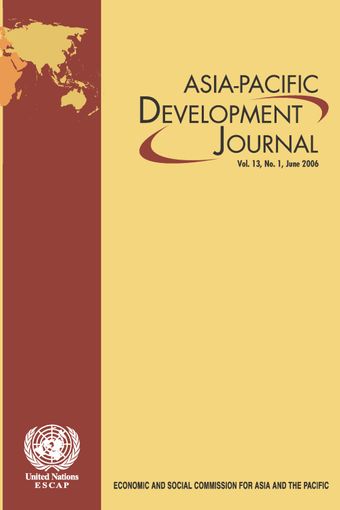-
How financial development caused economic growth in APEC countries: Financial integration with FDI or privatization without FDI
- Source: Asia-Pacific Development Journal, Volume 13, Issue 1, 10月 2006, p. 75 - 100
-
- 06 10月 2006
Abstract
Politicians fashionably argue in favour of financial development to promote economic growth following the seminal study of King and Levine (1993a and 1993b). Financial development, however, could come through alternative channels that are sometimes not compatible in small, open economics. A relatively popular channel promotes privatization of domestic financial intermediaries but with restrictions on foreign ownership. The other competing channel works through foreign direct investment (FDI) requiring foreign ownership of national assets. Until the last decade of globalization, from the 1960s through the early 1990s, in many Asia-Pacific Economic Cooperation (APEC) economies and especially in East Asia, privatization of national banks went hand in hand with barriers against FDI. The recent trend in globalization creates a political tension between those who welcome and the others who oppose FDI. This paper evaluates the relative contribution of those two alternative channels of financial development to economic growth. The model of analysis builds on King and Levine (1993b) but restricts its attention to small open economies of APEC. Contrary to the previous findings, privatization of the domestic financial sector alone turns out to have a negative impact on the growth of productivity and a weakly negative impact on the growth rate of per capita income. This discrepancy could possibly be rationalized by a special characteristic of the APEC sample where endogenous credit rationing by privatized banks could have lowered the relative proportion of entrepreneurs in the economy for reasons presented in Stiglitz and Weiss (1981). In this environment, FDI could serve as a catalyst to increase entrepreneurial access to international credit, which in turn could raise productivity by inducing additional entrepreneurial activities in the economy. However, financial integration led by FDI does bring the prospect of lower economic growth due to increased business fluctuations, especially for the small open economies. Nevertheless, it is surprising to find that a significant improvement in efficiency and growth was experienced by the APEC nations through the international channel with the flow of FDI. Consequently, barriers to globalization out of purely nationalist concerns may be ill-fated even for small open economies.





